As important as keeping the ship afloat is, the purpose of a warship is not to float. It is intended to fight, and there are many ways a ship could be knocked out of a fight without succumbing to flooding or fire. Even though the crew would vastly prefer a mission kill over an actual kill, it's nearly as good from the enemy's perspective. In addition to their attention to the aforementioned threats, designers and operators thus have to figure out how to keep fighting despite damage.
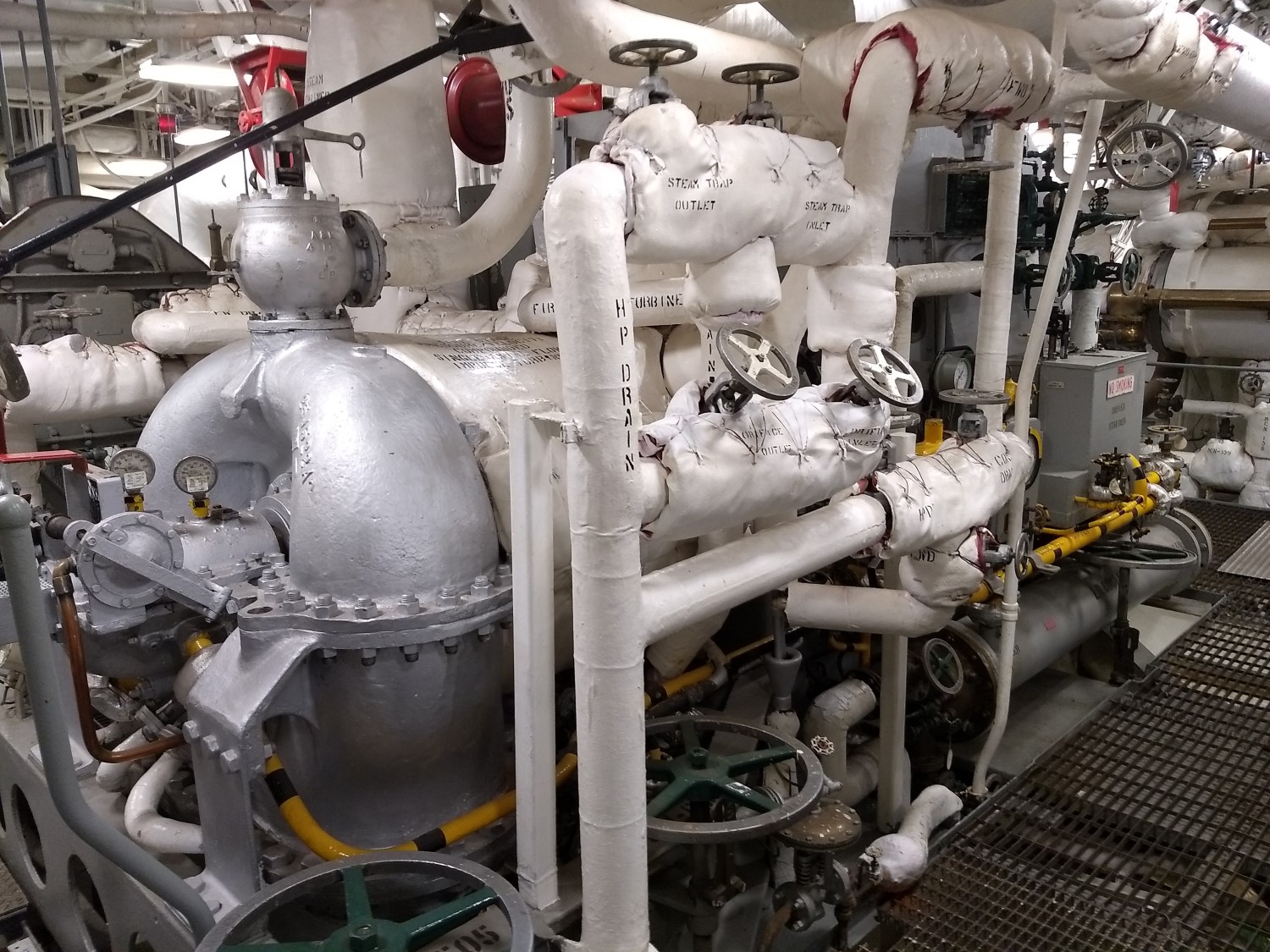
A turbogenerator in engine room 2 of Iowa1
The most likely source of a mission kill is loss of power. If the steam stops, the ship is a sitting duck,2 while loss of electrical power renders the ship unable to fight effectively. The main defense is redundancy. The boilers, which provide steam to both the engines and the generators, were usually split into two or more separate systems in separate spaces. This required careful design, and some early systems were reportedly compromised by common lubrication oil lines. Cross-connections allowed the crew to route around damage, so that a ship which lost, say, boiler 3 and engine 2 could use boiler 2 to power engine 3. Primary electrical power was from steam-driven turbogenerators, and these were dispersed throughout the engineering spaces. Diesel generators were fitted to provide reduced power if steam was lost, and widely separated from the turbogenerators and each other.
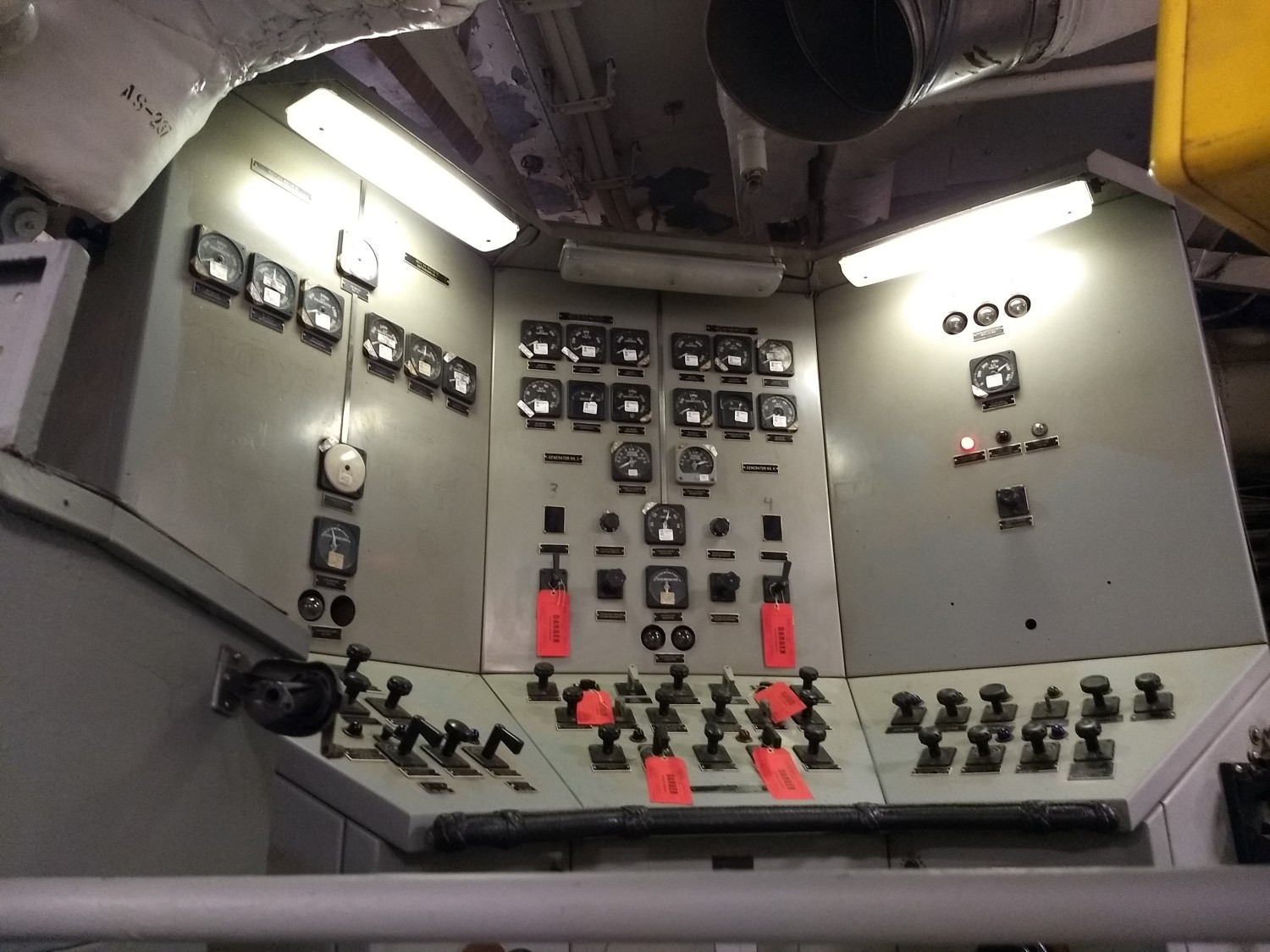
One of Iowa's main electrical switchboards
But the real Achilles heel of electrical power was distribution. In a number of cases, ships with operational generators were disabled due to problems with the electrical system. The most prominent example was the USS South Dakota at the Naval Battle of Guadalcanal. When she first opened fire, the shock caused a circuit breaker to close, connecting two different power phases and knocking out power throughout much of the ship for about a minute. The crew soon fixed the problem, except for two of the 5" mounts, which remained offline.
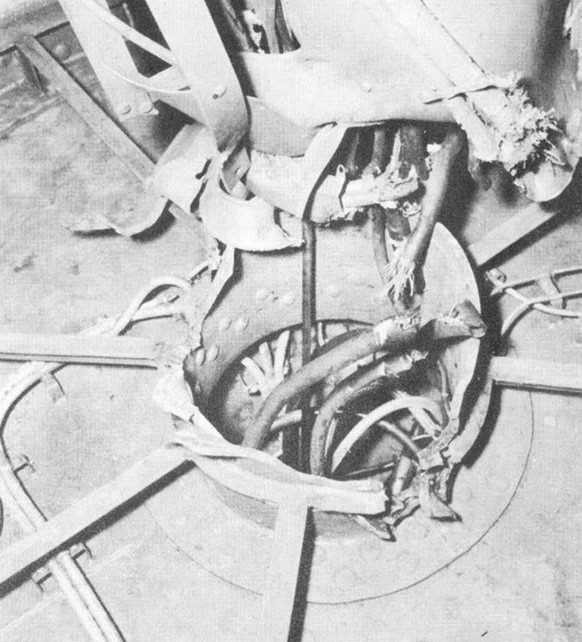
The wires of South Dakota's forward secondary director
Most critically, however, the loss of power took down the radars, giving all hands "a feeling of being blindfolded". The loss of situational awareness caused South Dakota to silhouette herself against a burning destroyer, and the Japanese quickly trained their searchlights on her. Over the next 15 minutes, she took a total of 26 hits from shells ranging from 5" up to 14". Most of these hit the superstructure and passed right through without bursting,3 but the fragments created on impact wreaked havoc with the superstructure wiring. Short circuits in the power, fire-control, and internal communications wiring resulted in main power being lost for about three minutes. In theory, the local fuses should have blown, isolating those circuits, but the main circuit breakers opened first, and the shorted circuits had to be manually isolated.
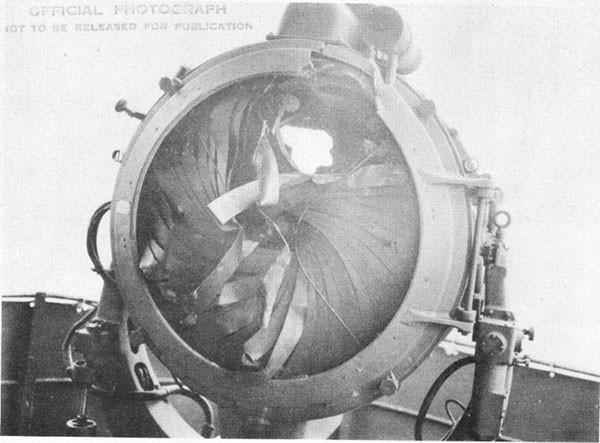
A destroyed searchlight aboard South Dakota
Even after power was restored, there was substantial damage remaining. All radio and radar equipment was inoperable, except for the radar on the aft main battery director. All cables to the forward secondary battery director were severed, as were other ducts, leads, and pipes. Minor fires were started, in some cases by the short circuits, and a total of 38 men were killed and 60 wounded.4
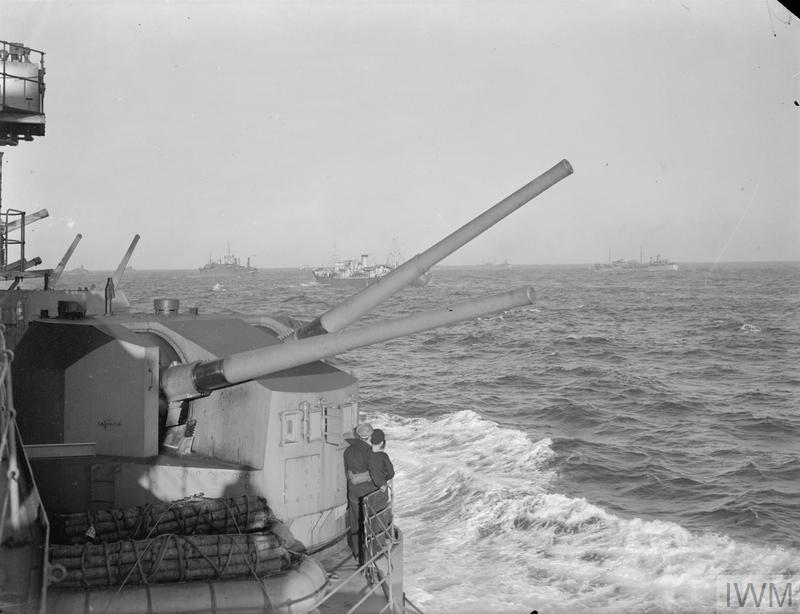
A 5.25" turret aboard Prince of Wales
Similar electrical problems occurred aboard HMS Prince of Wales during her last battle. The initial impact knocked out five of the eight generators, and cut power to the entire aft ring main, as well as six of the eight secondary turrets. The steering gear was also knocked offline, preventing the ship from dodging more torpedoes. The catastrophic effects of the loss of electrical power meant that HMS Vanguard, then under design, saw many auxiliaries, such as pumps and ventilation, changed from electrically-powered to steam-driven. More diesel generators were fitted and scattered throughout the ship, as both of PoW's were lost to the first torpedo hit.
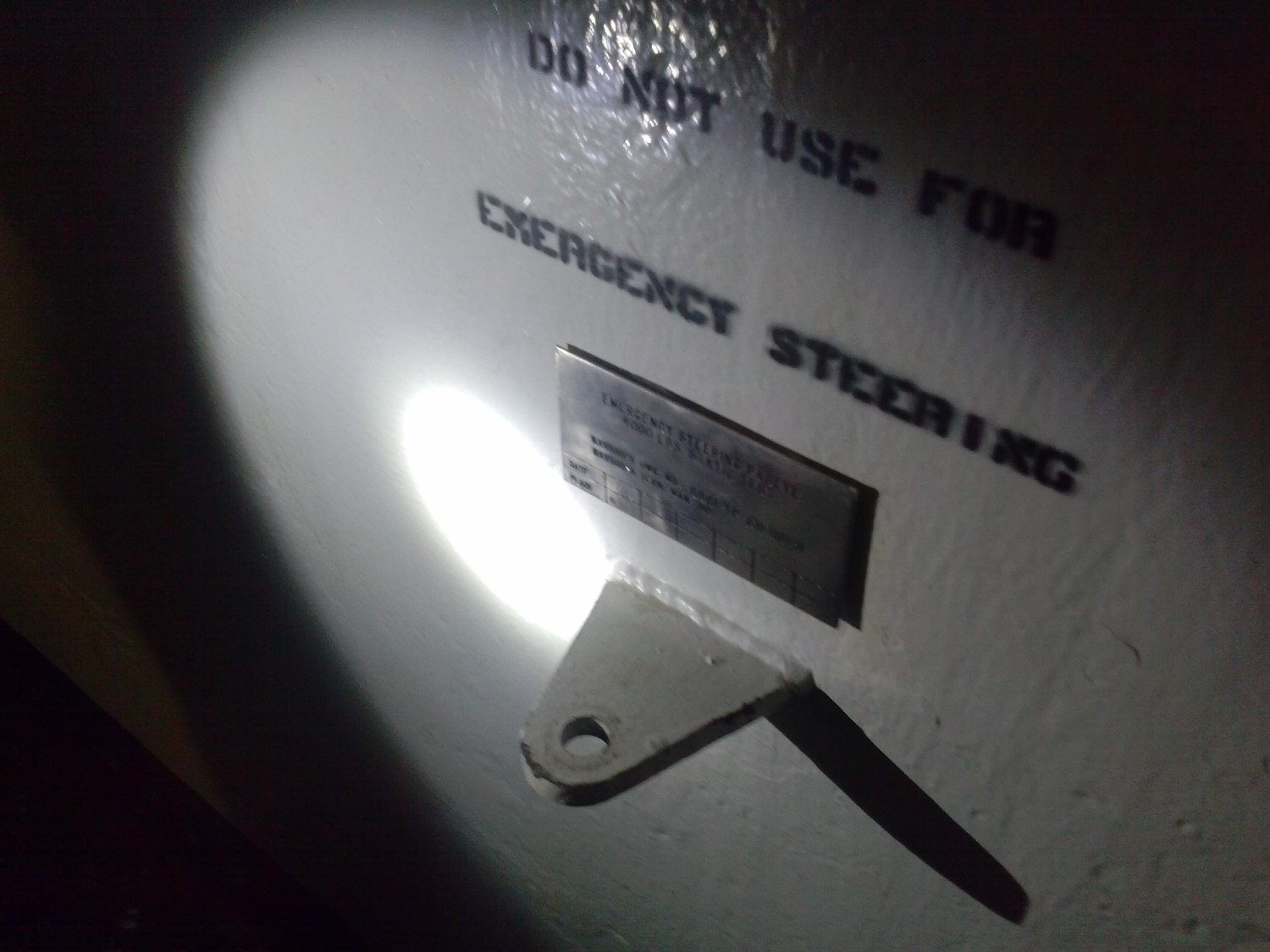
An emergency steering eye on Iowa. No, I don't have a good explanation for the warning above it.5
Of course, there are many ways to mission-kill a ship besides causing electrical problems, and several of these were demonstrated by Bismarck during her cruise. The shell hit from Prince of Wales after Hood's destruction contaminated a significant amount of fuel,6 and a later torpedo hit on her rudder from a Fairey Swordfish doomed the German ship. When the British finally caught up with her, her armor held up very well, but her combat-effectiveness was quickly destroyed by hits on the lightly-armored portions of the ship. The forward director was taken out by an 8" cruiser shell about 15 minutes into the engagement, and the aft director followed half an hour later. British shellfire soon riddled the conning tower and put the turrets out of action, but she remained under power and afloat for another hour. Surprisingly, Bismarck managed to avoid taking any shaft hits, but the exposed nature of the last part of the propulsion system was a definite vulnerability, even ignoring the propensity of bent shafts to form flooding paths.
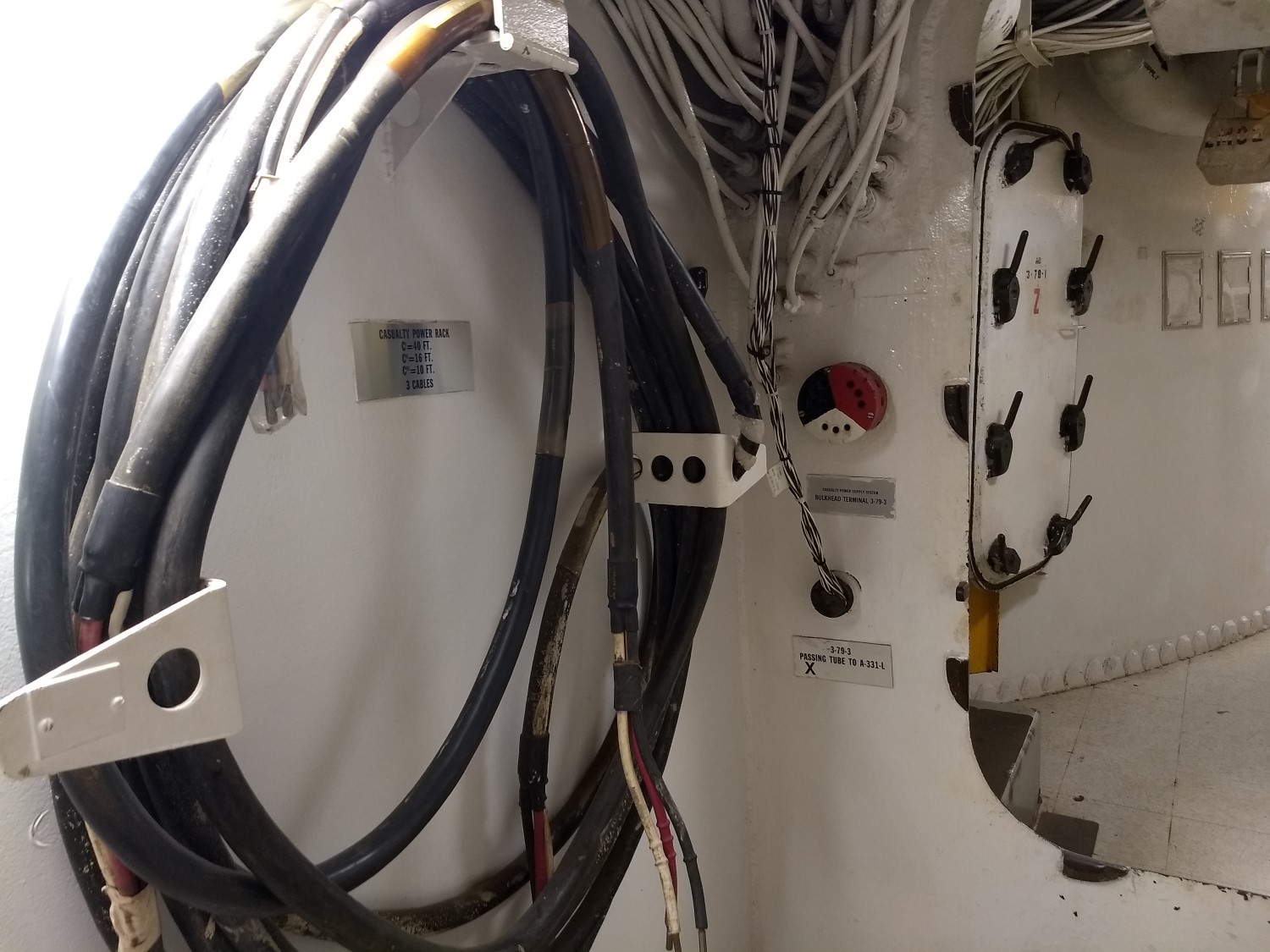
An emergency power cable aboard Iowa. The colored circle in the center is a connection for passing power through bulkheads.
Another major risk was shock damage, from underwater explosions or more rarely from the ship's own guns. Besides the electrical problems that South Dakota experienced, shock could easily break machinery foundations, unseat turrets, and injure crewmembers.
Mission kills are difficult to protect against because many of the components required to accomplish the mission must be exposed to do their work. The proliferation of electronics on modern warships has made the situation worse, as radar antennas must be large and mounted high in the ship, where topweight makes them impossible to protect. But redundancy and good design allows ships to keep moving and fighting despite damage.
1 All Iowa pictures are from my collection. ⇑
2 Not all warships use steam, but the principles are the same if the ship is diesel or gas turbine, and the extension to those forms of propulsion is obvious. ⇑
3 The Japanese had designed their AP shells with very long delays in hopes of getting hits below the waterline, so this happened during a number of battles. ⇑
4 The problems posed by damage to electrical leads have gotten worse since then. During the Falklands War, a British frigate was disabled by a single 30mm hit to the main data bus. ⇑
5 If it were to be used for emergency steering, a come-along would be stretched between it and an eye on the rudder post, and used to turn the rudder. ⇑
6 A related problem doomed the Panzerschiffe Graf Spee during the Battle of the River Plate. The British destroyed her fuel-processing equipment, which meant she could not use most of the intact fuel. ⇑

Comments
How is steam more reliable than electrical for power? My understanding is that steam is under a great deal of pressure, and a minor kink in a steam pipe can result in it being unusable, whereas a bend in electrical wiring is pretty common. Is this an issue where we have a lot of experience from industry on how to handle steam problems, but little experience with electrical lines being severely damaged?
Was onboard fuel processing common? I don't remember it coming up in any of the propulsion posts.
@Garrett
Not exactly. The biggest issue isn't wiring vs pipes, it's the likelihood of a steam failure vs an electrical failure.
Steam distribution is fairly robust, the steam-powered auxiliaries are close to the sources of steam, and it was pretty rare for a single hit to take out all sources of steam. But it wasn't uncommon for failures in the electrical system to shut off power to the whole ship because the breakers trip.
@ADA
Graf Spee was diesel-powered, and AIUI diesels are a lot more picky about their fuel than boilers are. I don't know all the details, and there is some water-separation stuff on steam plants, but it's mostly a diesel thing.
On-board fuel processing is common because marine fuel oil varies widely in quality, especially when procured in colorfully exotic foreign ports, and "basically asphalt" is within the common range. Apply heat, several levels of filtration, and water extraction before you put that anywhere near the engine you're counting on to get you home.
And Graf Spee would have had this problem worse than most. First, because she used newfangled diesel engines in an era when almost everyone else ran on steam, and the fuel injectors on a diesel engine are a bit more finicky than those in a steam boiler. Second, because she was designed as a commerce raider and so would be taking on fuel not just from colorfully exotic foreign ports but from the bunkers of her prizes.
I wonder if that emergency steering eye warning was supposed to read: "Do not use." "For emergency steering."
Because that would make a lot more sense.
And I will say that the Iowa's main switchboard is a lot simpler than I expected.
@doctorpat
I suppose it's possible. There are days when the Navy is baffling and stupid.
And I should probably point out that there are a couple switchboards in that engine room, and presumably others throughout the ship. I'm not really sure why I labeled it that. I do know that that one is energized, which is why the picture is taken from so far back.
The sign on the steering eye reminds me of a cast hitching rail with a cast in sign that was made in Mexico or somewhere in the early 1900s. It was originally English but had been copied multiple times by non-english-literate mexican craftsmen.
It had the words "TOTI EMUL ESTO" cast into the metal.
To tie mules to.
"Firing the main guns plays merry havok with the ship's electrical system" seems like something that should've been discovered during South Dakota's trials and shakedown.
Regarding radars on modern warships being impossible to protect, it's not just topweight that's the problem. Metal blocks radio waves, meaning that putting armor around a radar antenna would render said antenna entirely useless.
It's not that the main guns inherently cause problems. Shock effects are quite unpredictable, and vary a lot depending on the bearing and elevation of the guns. Firing trials tend to be conducted in fairly safe directions because fixing the damage that happens if you point them in unfavorable directions is a pain. Combat is rarely so kind. Nor was it a design problem. Massachusetts had fought at Casablanca a few days before SoDak, and while blast knocked out several of her radars, it never hit the main electrical system.
@bean Isn't part of the point of trials to uncover issues with the ships before they go into combat? Like you say, firing the guns in combat will often require that they be pointed in unfavorable directions; better to uncover any unexpected issues that occur when firing in unfavorable directions (like the potential for the SoDaks' muzzle blast to disable large parts of their electrical system) during trials than to first encounter them when the enemy is firing back.
In theory, yes. In practice, they seem to have screwed it up somehow. I don't know how much of that was not doing a through job, and how much was the fact that shock isn't that predictable. Maybe the problem only occurs with the guns in a fairly narrow window of positions. Even if we assume that the situation is symmetrical and that the window for a problem is 5 deg in both train and elevation, you're still looking at a total of 243 positions to test for each gun, which was a significant fraction of the total barrel life at the time.
@bean Still, better to wear out a battleship's worth of gun barrels in the process of testing whether firing them at particular angles causes the ship major issues than to have the ship crippled in battle by one of said major issues (and potentially sunk as a result) because they weren't discovered in testing. You lose a battleship's worth of gun barrels either way, only in the second case you potentially lose the rest of the battleship as well.
Also, typo in footnote 6: it's Graf Spee (only one F), not Graff Spee.
Vikki:
Then make your armor out of plastic.
:-p